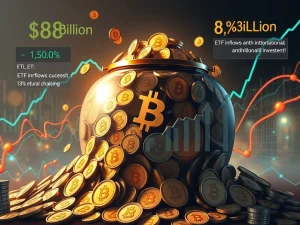Intriguing Theory: Will Quantum Computers Force Satoshi Nakamoto Out of Hiding?

The mystery surrounding Satoshi Nakamoto, the pseudonymous creator of Bitcoin, has captivated the crypto world for over a decade. Could the emergence of quantum computers, a technology once confined to science fiction, finally unravel this enigma? According to early cypherpunk and Bitcoin pioneer Adam Back, the answer might be a resounding yes. Buckle up, crypto enthusiasts, because this revelation could change everything you thought you knew about Bitcoin and its enigmatic founder.
Quantum Computers: A Looming Threat to Bitcoin Security?
Adam Back, a name synonymous with early cryptography and cited in the Bitcoin whitepaper itself, recently stirred the pot at the “Satoshi Spritz” event in Turin. His intriguing proposition? The growing threat of quantum computers might just be the catalyst that forces Satoshi Nakamoto to resurface. But how exactly could these futuristic machines achieve what years of speculation and investigation have failed to do?
Back’s reasoning is rooted in the potential vulnerability of Bitcoin’s current cryptography to quantum computing threat. While today’s quantum computers aren’t powerful enough to crack Bitcoin’s security, Back predicts a shift within the next two decades. This looming threat could necessitate a significant upgrade to Bitcoin’s infrastructure.
The Quantum Computing Clock is Ticking: What’s the Deadline?
Adam Back estimates that the critical juncture, when quantum computers pose a real danger to Bitcoin, is roughly “twenty years” away. This might seem like a comfortable buffer, but in the fast-paced world of technology, two decades can vanish in the blink of an eye. So, what exactly is the concern?
- Vulnerable Addresses: Bitcoin addresses created using older signature schemes could become susceptible to attacks from powerful quantum computers.
- Asset Security at Risk: If these vulnerabilities are exploited, Bitcoin holdings in these older addresses could be at risk of theft.
- Community Choice: Faced with this threat, the Bitcoin community will need to make a crucial decision – deprecate these older addresses or risk significant losses.
Back believes the community will likely opt to deprecate these vulnerable addresses. This decision, while necessary for the long-term security of Bitcoin, could inadvertently force Satoshi Nakamoto’s hand.
Will Satoshi Nakamoto Be Forced to Move Their Bitcoin?
Imagine a scenario where Bitcoin implements quantum-resistant signature technology to safeguard against the quantum computing threat. Holders of Bitcoin in older, vulnerable addresses would be compelled to move their funds to these new, secure addresses. This is where the intriguing possibility of revealing Satoshi Nakamoto arises.
Satoshi Nakamoto, believed to hold a significant amount of early Bitcoin, has remained completely inactive for years. If they wish to protect their substantial Bitcoin fortune from potential quantum computers attacks in the future, they would need to move their coins. This very act of moving dormant Bitcoin, associated with the genesis era, could serve as undeniable proof that Satoshi is indeed alive and still in control of their private keys.
Privacy Upgrades: A Wildcard in the Satoshi Nakamoto Mystery?
However, the plot thickens. Adam Back acknowledges that advancements in Bitcoin privacy technologies could throw a wrench into this seemingly straightforward scenario. Ongoing research into enhancing Bitcoin’s privacy might offer solutions that allow for quantum resistance without necessarily revealing the movement of funds.
“It depends a bit on the technology, there are some research ideas that could add privacy to Bitcoin,” Adam Back explained. “So, possibly there might be a way to fix quantum issues while keeping privacy.”
This introduces an element of uncertainty. If Bitcoin successfully integrates privacy-preserving quantum resistance, Satoshi might be able to secure their coins without leaving a trace, keeping their anonymity intact.
The Skeptic’s View: Will Satoshi Remain Silent Regardless?
Not everyone is convinced that the quantum computing threat will compel Satoshi Nakamoto to act. An anonymous early Bitcoin miner, quoted by Crypto News Insights, expressed skepticism, suggesting that Satoshi might choose to remain passive, even in the face of quantum vulnerabilities.
“Even if he is alive and holds the private keys, I do not think he’d move them. Based on how he acted so far I would rather expect him to let the community to decide.”
This perspective highlights the unpredictable nature of Satoshi Nakamoto. Their past actions suggest a preference for decentralization and community-driven decisions. It’s plausible that Satoshi might leave the decision of handling vulnerable early Bitcoin addresses to the broader Bitcoin community, even if it means risking their own holdings.
Quantum-Resistant Bitcoin: A Necessary Evolution
Regardless of whether it reveals Satoshi Nakamoto, the transition to quantum-resistant Bitcoin is increasingly viewed as an inevitable step. Adam Back clarifies that implementing quantum-resistant signatures isn’t a simple plug-and-play solution. Challenges exist:
- Security Concerns: Some quantum-resistant signature implementations are still unproven and require rigorous testing.
- Data Overhead: Proven methods, like Lamport signatures, can be data-intensive, potentially impacting Bitcoin’s efficiency.
Back proposes a pragmatic approach – a Taproot-based implementation that allows Bitcoin addresses to switch to quantum-resistant signatures only when necessary. This would enable a gradual and measured transition, minimizing disruption while proactively addressing the quantum computing threat.
Key Takeaways: The Quantum Quandary and Satoshi’s Potential Return
The prospect of quantum computers impacting Bitcoin security is no longer a distant sci-fi fantasy. Here’s what you need to know:
| Key Aspect | Details |
|---|---|
| Quantum Computing Threat | Posed to older Bitcoin addresses within the next two decades. |
| Community Decision | Bitcoin community may need to deprecate vulnerable addresses. |
| Satoshi Nakamoto Revelation? | Forcing Satoshi to move coins could reveal their activity, unless privacy upgrades intervene. |
| Quantum Resistance is Crucial | Bitcoin must evolve to incorporate quantum-resistant cryptography for long-term security. |
Will quantum computers be the unlikely catalyst that finally brings Satoshi Nakamoto back into the spotlight? Only time will tell. But one thing is certain: the intersection of quantum computing threat and Bitcoin’s future is set to be a fascinating and potentially revealing chapter in the ongoing crypto saga. Keep your eyes peeled, the crypto world is about to get even more intriguing.









